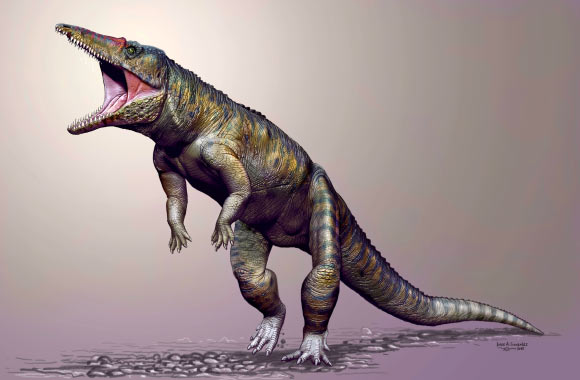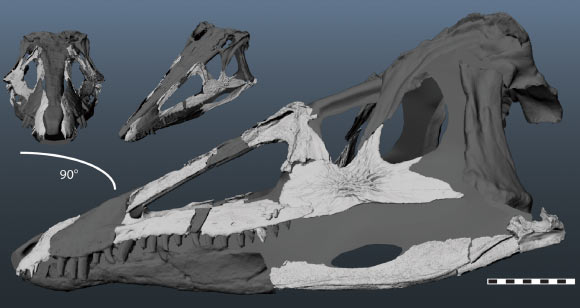A new species of prehistoric crocodile that dates back 231 million years ago (Carnian stage of the Triassic period) has been identified by a team of paleontologists led by Dr Lindsay Zanno of North Carolina State University and the North Carolina Museum of Natural Sciences.
The newly-discovered creature, named Carnufex carolinensis, or the Carolina Butcher, is one of the world’s earliest and largest crocodylomorphs (Crocodylomorpha), a group of creatures that includes modern and extinct crocodile relatives.
It was about 9 feet (2.7 m) long, walked on its hind legs, and likely preyed upon smaller inhabitants of North Carolina ecosystems such as armored reptiles and early mammal relatives.
The fossilized skull, spine and upper forelimb of Carnufex carolinensis were collected from the Upper Triassic Pekin Formation in Chatham County, North Carolina.
“Fossils from this time period are extremely important to scientists because they record the earliest appearance of crocodylomorphs and theropod dinosaurs, two groups that first evolved in the Triassic period, yet managed to survive to the present day in the form of crocodiles and birds,” said Dr Zanno, who is the first author of a paper published in the journal Scientific Reports.
Dr Zanno and her colleagues suggest that Carnufex carolinensis may have filled one of North America’s top predator roles before dinosaurs arrived on the ancient supercontinent Pangea.
“Typical predators roaming Pangea included large-bodied rauisuchids and poposauroids, fearsome cousins of ancient crocodiles that went extinct in the Triassic Period. In the Southern Hemisphere, these animals hunted alongside the earliest theropod dinosaurs, creating a predator pile-up,” Dr Zanno said.
“However, the discovery of Carnufex carolinensis indicates that in the north, large-bodied crocodylomorphs, not dinosaurs, were adding to the diversity of top predator niches.”
Susan Drymala of North Carolina State University and the North Carolina Museum of Natural Sciences, a co-author of the discovery paper, added: “as theropod dinosaurs started to make it big, the ancestors of modern crocs initially took on a role similar to foxes or jackals, with small, sleek bodies and long limbs. If you want to picture these animals, just think of a modern day fox, but with alligator skin instead of fur.”
_____
Lindsay E. Zanno et al. 2015. Early crocodylomorph increases top tier predator diversity during rise of dinosaurs. Scientific Reports 5, article number: 9276; doi: 10.1038/srep09276









